From the first U.S. Supreme Court ruling to address homosexuality to the first bisexual "Bachelorette," here are 10 historic LGBTQ milestones from around the world.
Kathy Kozachenko
First out gay person elected to office in the U.S.
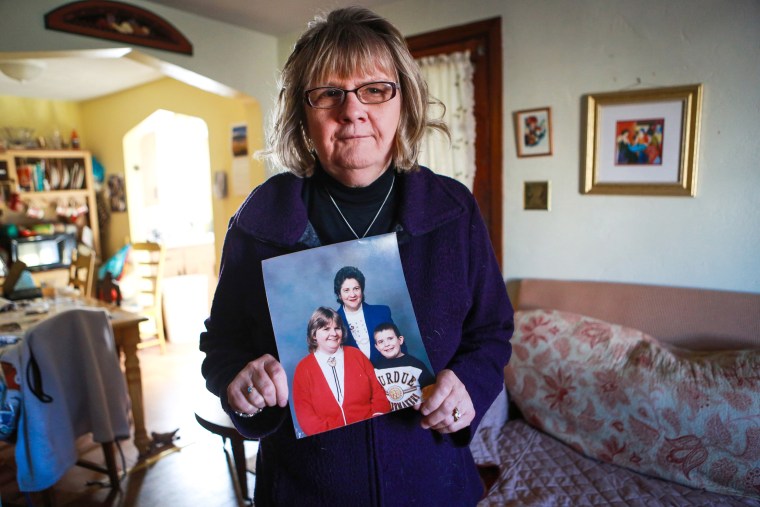
Three years before Harvey Milk was elected to the San Francisco Board of Supervisors, out lesbian Kathy Kozachenko was voted onto the Ann Arbor City Council in Michigan on April 2, 1974.
Kozachenko was just 21 and a student at the University of Michigan, a hotbed of anti-war protests and activism supporting racial justice, women’s rights and other causes.
Her sexual orientation didn’t seem to be an issue with voters, and “gay liberation was not a major issue in the campaign,” Kozachenko said in her victory speech, Bloomberg reported.
“This year we talked about rent control. We talked about the city’s budget. We talked about police priorities, and we had a record of action to run on,” she said at the time.
Kozachenko only served one two-year term and eventually moved to Pittsburgh, where she remained involved in gay activism and met her longtime partner, MaryAnn Geiger.
“I am so proud of all the activists that came after me,” Kozachenko told NBC News last year. “The people that pushed and pushed and pushed for gay marriage, the transgender people that have pushed for their rights ... I’m grateful for the chance that I was able to play a small part in this.”
‘Wings’ (1927)
First male-male kiss in a Hollywood movie
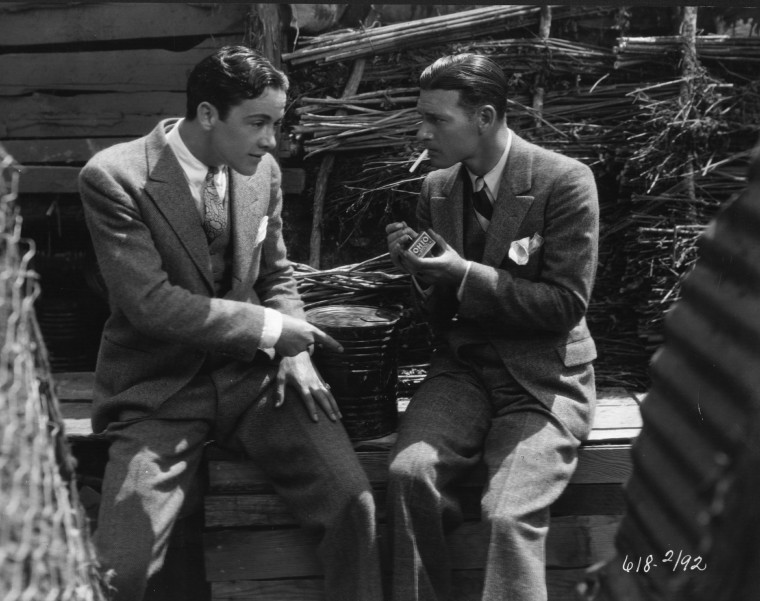
William A. Wellman’s silent film “Wings,” the first movie to win the Academy Award for best picture, follows Jack (Charles Rogers) and David (Richard Arlen) as they enlist in the Army Air Service during World War I and bond during basic training before being shipped off to France.
While they’re ostensibly romantic rivals for “it girl” Clara Bow, neither “shows as much love for her … as they do for each other,” queer writer Kevin Sessums wrote, according to the LGBT History Project blog.
In the pre-Hays Code film’s climax, Jack accidentally shoots down David, who has commandeered a German biplane. Running to his dying friend’s side, Jack takes David in his arms and begs forgiveness. As the camera zooms in, the two stroke each other’s hair tenderly and Jack declares, “You know there is nothing in the world that means so much to me as your friendship.”
The men share a lingering closed-lip kiss before Jack takes his final breath.
“While the relationship is referred to repeatedly as a friendship, the acting and directing of the film make it obvious that the men’s feelings were romantic,” wrote culture critic and curator Francesca Seravalle. “A swell of romantic string instruments plays in the background as Jack mourns over Dave’s still body. The directing choices made by Wellman humanized both characters and allowed the audience to experience the tragedy without exploiting the perceived exoticness of a relationship between two men.”
One, Inc. v. Olesen
First U.S. Supreme Court ruling to address homosexuality
Founded in 1952, ONE, Inc. was one of the earliest gay rights organizations in the United States and the first to have its own offices.
An accompanying magazine, One Magazine, started publication in 1953 — selling through subscriptions and at Los Angeles newsstands — and is considered the first mass-produced gay publication in America.
In October 1954, L.A. Postmaster Otto K. Olesen refused to deliver the magazine, declaring it “obscene, lewd, lascivious and filthy.” ONE sued but lost the case and a subsequent appeal — a panel of federal judges declared "Sappho Remembered," a lesbian love story that ran in one issue, “nothing more than cheap pornography calculated to promote lesbianism.”
Founding editors Dale Jennings and Don Slater appealed all the way to the Supreme Court, which, surprisingly, agreed to hear their case.
On Jan. 13, 1958, without even hearing oral arguments, the justices issued a terse, one-line ruling reversing the 9th U.S. Circuit Court of Appeals decision and affirming that the mere subject of homosexuality was not obscene.
In a Washington Post op-ed in 2014, Brookings Institution fellow Jonathan Rauch called One, Inc. v Olesen “the seminal gay rights case in America — the one that extended First Amendment protection to gay-related speech.”
Marcia Kadish & Tanya McCloskey
First same-sex couple legally married in the United States
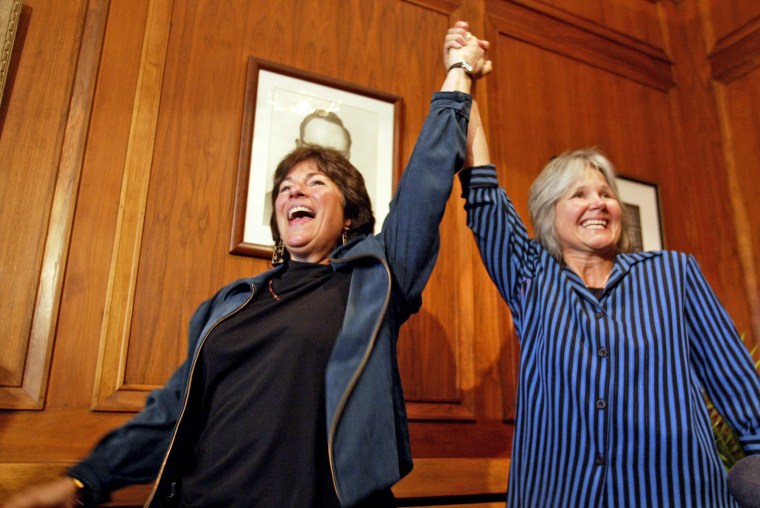
On Nov. 18, 2003, Massachusetts became the first state to recognize same-sex marriage when, in Goodridge v. Department of Public Health, the state Supreme Court ruled it could not “deny the protections, benefits, and obligations conferred by civil marriage to two individuals of the same sex who wish to marry.”
“Recognizing the right of an individual to marry a person of the same sex will not diminish the validity or dignity of opposite-sex marriage,” wrote Chief Justice Margaret Marshall, “any more than recognizing the right of an individual to marry a person of a different race devalues the marriage of a person who marries someone of her own race.”
The first licenses were issued on May 17, 2004, and McCloskey and Kadish, who had already been together nearly 20 years at that point, picked theirs up a few minutes after midnight. With a waiver that allowed them to skip the traditional three-day waiting period, the women exchanged vows later that morning at Cambridge City Hall.
"We felt we were married already," Kadish told NPR’s "Morning Edition" in 2019. "This was just making it legal."
At least 78 same-sex couples married in Massachusetts that day — the same day President George W. Bush called for a congressional amendment banning same-sex marriage.
"The sacred institution of marriage should not be redefined by a few activist judges," Bush said in a statement. "All Americans have a right to be heard in this debate."
It wasn’t until 2015 that McCloskey and Kadish’s union was recognized federally, when the U.S. Supreme Court effectively made same-sex marriage the law of the land in Obergefell v. Hodges.
By that time, McCloskey had been diagnosed with endometrial cancer. The disease spread quickly, and she died on Jan. 6, 2016.
"We wanted to lead by example, not that we were leaders of anything," Kadish told NPR. "We just wanted to make sure that the world saw the most positive side of being a gay couple."
While Kadish and McCloskey were the first same-sex couple legally wed in the U.S., a marriage license mistakenly issued to gay couple Michael McConnell and Jack Baker back in 1971 was retroactively validated in 2019, making them the longest-married same-sex couple in the world.
Chicago’s Gay Liberation March
First gay pride march
One day before the first Christopher Street Liberation Day march in New York, the Windy City hosted the world’s first Pride march on June 27, 1970 — albeit a much smaller one than the Big Apple’s. The half-mile procession officially went from Washington Square Park to the Water Tower at the bustling intersection of Chicago and Michigan avenues, but many participants continued down to the Civic Center plaza (now Daley Plaza).
Once there, about 150 people listened to speeches at the plaza before doing a “chain dance around the Picasso statue as the marchers shouted, ‘Gay power to gay people,’” the Chicago Tribune reported.
Chicago Gay Liberation, which organized the event, chose the date because the Stonewall uprising had started on the last Saturday in June the year prior. The members also wanted to reach the biggest crowd of shoppers on Chicago’s Magnificent Mile.
Today, the Chicago Pride Parade takes place on the last Sunday of June, drawing more than 800,000 people to North Halsted Street, long known as “Boystown.”
Jóhanna Sigurðardóttir
First out LGBTQ prime minister
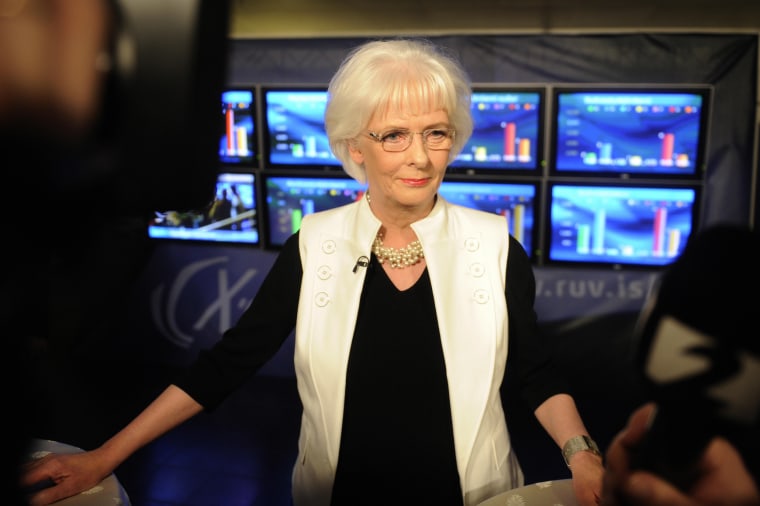
While gay finance minister Per-Kristian Foss was briefly in charge of Norway in 2002 when both the prime minister and foreign minister were traveling abroad, Iceland’s Jóhanna Sigurðardóttir is the world’s first openly LGBTQ elected head of state.
A former flight attendant, Jóhanna was first elected to the Althingi (Iceland’s parliament) in 1978 as part of the Social Democratic Party. Throughout her career, she has also served as deputy speaker of the Althingi, vice chair of the SDP and minister of social affairs.
On Feb. 1, 2009, Jóhanna was formally sworn in as Iceland’s first female prime minister and the first out LGBTQ world leader in modern history. She served from 2009 to 2013, steering the country’s economy “back on solid footing” after the massive financial crisis, according to Britannica, with the country’s GDP growing 3 percent in both 2011 and 2012.
She and girlfriend Jónína Leósdóttir entered into a civil union in 2002. In 2010, when Iceland recognized same-sex marriage midway through Jóhanna’s tenure, the pair became one the first same-sex married couples in the country.
Society for Human Rights
First officially recognized gay rights group in the U.S.
German immigrant Henry Gerber launched the Society for Human Rights out of his Chicago home in 1924 and received an official charter from the state of Illinois, making it the first incorporated group devoted to gay rights in the U.S.
The society’s publication, Friendship and Freedom, is believed to be the first American publication for gay people.
Stationed in his former homeland during World War I, Gerber witnessed Berlin’s thriving gay subculture and was influenced by the work of pioneering sex researcher Magnus Hirschfeld.
Returning to the States, he took a job with the post office and founded the society out of his apartment at 1710 N. Crilly Court in Chicago’s Old Town Triangle neighborhood.
But the organization lasted less than a year, disbanding in 1925 after police raids on both a member’s home and Gerber's apartment. Gerber was fired from the post office and eventually moved to New York, where he continued advocating for gay rights until his death in 1972.
In 2015, Gerber’s Chicago home was designated a National Historic Landmark by the National Park Service.
Renée Richards
First transgender tennis player to compete in the U.S. Open
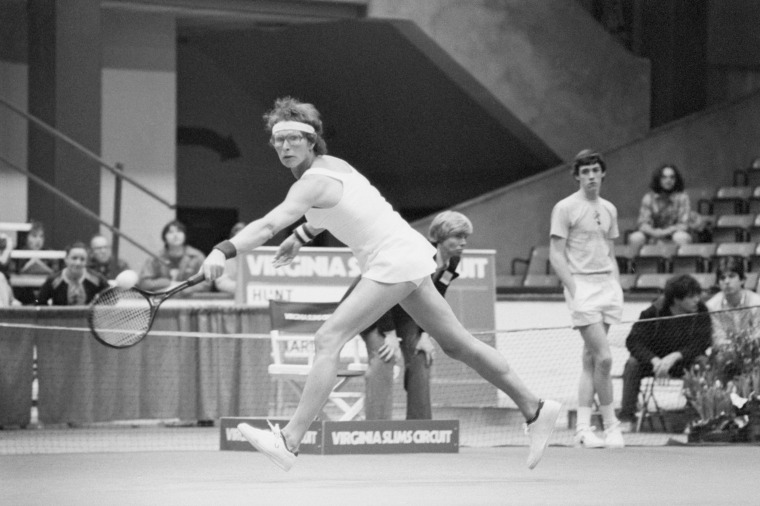
Renée Richards was set to play in the 1976 U.S. Open until officials learned she was assigned male at birth and attempted to ban her from competing.
Richards had been a tennis prodigy from a young age, playing in the men’s Open several times and even making the semifinals in 1972. A successful ophthalmologist, she medically transitioned in 1975 and began living as Renée Richards (the name Renée meaning "reborn").
She kept a fairly low profile — entering a 1976 competition as Renée Clark — but her transition was “outed” in a local news report by San Diego reporter Dick Carlson, father of Fox News pundit Tucker Carlson. Fans rooted against her, with shirts reading “Go away, Renee,” and late-night talk show hosts made crude jokes.
When Richards entered the Tennis Week Open in 1976, 25 of the 32 women in the competition withdrew.
To keep Richards off the court, the United States Tennis Association started demanding a chromosome test for all female players. She challenged that policy in a case that went before the New York Supreme Court.
Mirroring arguments made by groups seeking to ban transgender athletes today, the USTA argued it was trying to maintain “fairness” in the face of “as many as 10,000 transsexuals in the United States and many more female impersonators or imposters” who would be eager to snatch “millions of dollars of prize money."
Billie Jean King, who had played doubles with Richards, testified that she “does not enjoy physical superiority or strength so as to have an advantage over women competitors in the sport of tennis."
In a landmark victory, the court ruled in Richards’ favor.
"When an individual such as plaintiff, a successful physician, a husband and father, finds it necessary for [her] own mental sanity to undergo a sex reassignment, the unfounded fears and misconceptions of defendants must give way to the overwhelming medical evidence that this person is now female," Judge Alfred Ascione wrote in the majority opinion.
Two weeks later, Richards played in the 1977 U.S. Open, where she lost to Wimbledon champ Virginia Wade in the first round. She did reach the doubles finals with Betty Ann Stuart, but the pair lost to Betty Stöve and a fiery new upstart named Martina Navratilova.
Four years later, Renée Richards retired from professional tennis at age 47. She continued her thriving ophthalmology practice and even coached Navratilova to two wins at Wimbledon.
Karl M. Baer
First person to surgically transition
Born in 1885 to a Jewish family in Arolsen, Germany, Baer was assigned female at birth, though the midwife told his father the baby’s body had “such strange” characteristics it was impossible to determine the gender.
In his 1907 autobiography, “Memoirs of a Man’s Maiden Years,” published under the pseudonym N.O. Body, Baer wrote about being ostracized at school and feeling ill at ease in his assigned sex.
While he is often referred to as transgender, today Baer would more accurately be considered intersex.
“I was born as a boy and raised as a girl,” he wrote. “One may raise a healthy boy in as womanish manner as one wishes and a female creature in as mannish; never will this cause their senses to remain forever reversed.”
In 1904, Baer moved to Hamburg to work as a social worker with the Jewish organization B’nai Brith. It was there that he began living as a man.
“I introduced myself as a man, never as a woman,” Baer wrote. “What am I really? Am I a man? Oh God, no. It would be an indescribable delight if I were. But miracles don’t happen anymore these days.”
Two years later, Baer was in a trolley accident in Berlin. He was rushed to the hospital, where doctors realized his ID listed him as female despite his presenting as male. They connected him with Magnus Hirschfeld, who diagnosed him as “a man who was mistakenly identified as a woman.”
With a permit from the Prussian Interior Ministry, Baer underwent a multistage gender confirmation procedure, Haaretz reported, though the exact details of the surgery are unknown. He was released from the hospital in December 1906 with a medical certificate identifying him as male. The following year, court clerks in Arolsen issued him a new birth certificate.
Others had transitioned socially before, but Baer “was unusual in that he used medical technology and surgical means to change his gender,” transgender historian Iris Rachamimov told Haaretz.
Brooke Blurton
First bisexual “Bachelorette”
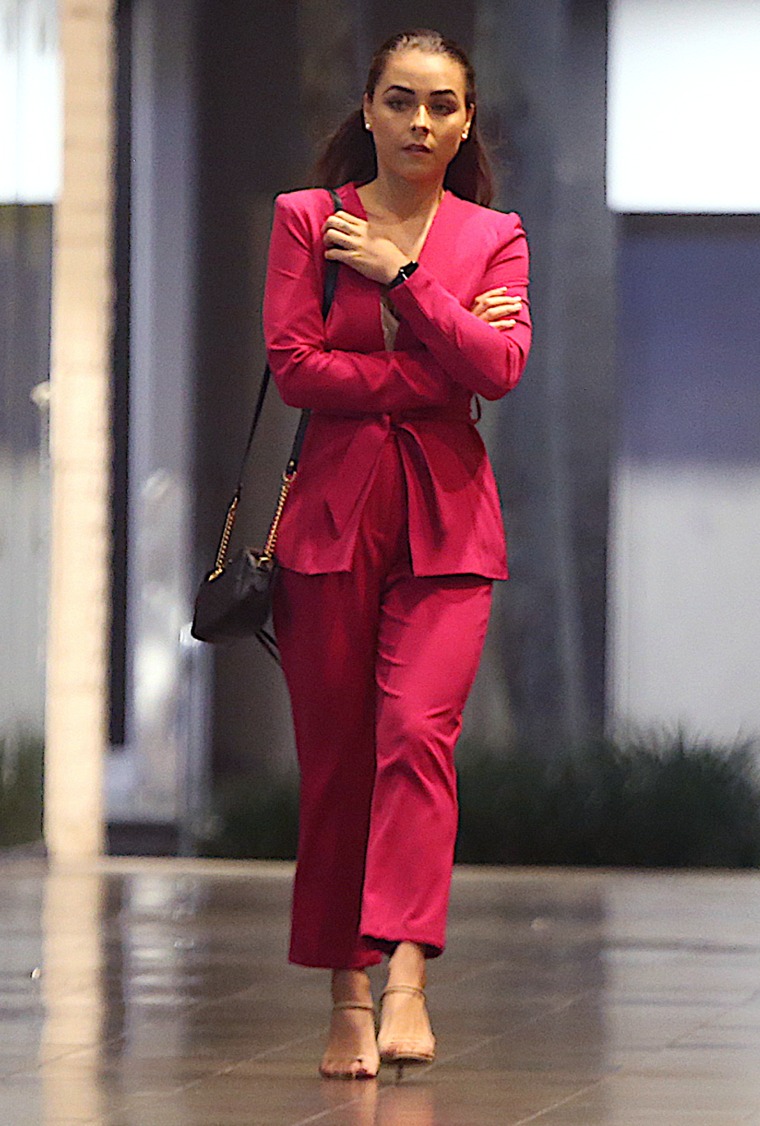
Since “The Bachelor” debuted on ABC in 2002, the marital-minded franchise has spawned multiple spinoff series and over 30 international editions. But it wasn’t until the upcoming season seven of “The Bachelorette Australia” that producers tapped an out member of the LGBTQ community to headline the show: 26-year-old Brooke Blurton, who is bisexual.
For the first time in the franchise’s history, the star will choose among both men and women during the rose ceremony.
“I am not too sure if Australia is ready for it,” Blurton, who previously appeared on the Down Under versions of "The Bachelor'' and “Bachelor in Paradise,” told The Daily Telegraph. “I certainly am. If it makes people feel uncomfortable in any way, I really challenge them to think about why it does.”
Blurton, a Noongar Yamatji woman from Western Australia, will also be the first Indigenous woman on the show.
“We are a nation of people from so many different backgrounds, so many different cultures and so many different experiences, yet we all have one thing in common — we all want to be loved in a way that is meaningful to us,” “Bachelorette” host Osher Günsberg said in a statement. “I can’t wait to get started on helping our Bachelorette Brooke find that kind of love.”
In the U.S., former “Bachelor” star Colton Underwood came out as gay in April, two years after appearing on the series’ 23rd season.